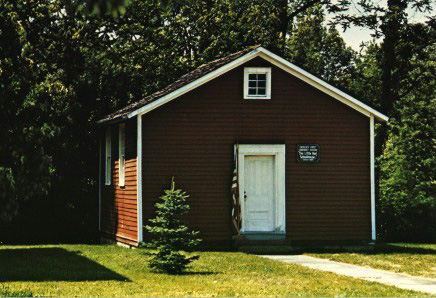Little Red Schoolhouse
 When Oberlin College opened its doors for learning in 1833, it wasn’t too long after that town and college leaders collaborated yet again for an educational goal: to build a school for their own children.
When Oberlin College opened its doors for learning in 1833, it wasn’t too long after that town and college leaders collaborated yet again for an educational goal: to build a school for their own children.
The townspeople raised $215 in a little more than a year to purchase a wood frame for a one-story building with a stone foundation that would measure 20 feet by 24 feet. Its initial location was the northeast corner of Main and Lorain streets. Built in 1836, the school opened in 1837 for 18 students, and for many years, it was the only school for Oberlin children. The school’s first teacher, Eliza Branch, was an Oberlin graduate. She used the popular materials of the time, the McGuffy Reader to help students learn to read and to reinforce the town’s values of hard work, honesty, and neighborliness.
People soon realized the building was too small to accommodate the town’s growing population. Rather than tear it down, in 1851, they built a newer, larger building on college property. As Oberlin began to develop its public school system, it built newer, larger structures such as the Union School House in 1874.
As for the original schoolhouse, over the years, a resident purchased it to serve as a family residence, and later a tailor’s shop and a sign painter’s shop. As time passed, neglect prompted city leaders to make plans to demolish it. In 1958, local businessman Clifford Barden led a campaign to preserve the schoolhouse and keep it from the wrecking ball. Barden and others secured sufficient funds to restore the building to its pioneer-era style and painted it red.
After its makeover, the city relocated the building, first to a hill overlooking Plum Creek on East Vine Street and again in 1968, when the Oberlin Historical and Improvement Organization (now known as Oberlin Heritage Center) had decided to create a type of historic strip development. The group wanted the schoolhouse to be part of the project. The Little Red Schoolhouse moved to its present site in 1997 at 73-1/2 South Professor St.
The schoolhouse is Oberlin's oldest building and the only structure left from the colony’s first decade. Today the schoolhouse serves as an educational resource center for individuals, schools, and community groups interested in Oberlin’s educational past and the history of one-room schools.
Sources: Electronic Oberlin Group, Oberlin Heritage Center